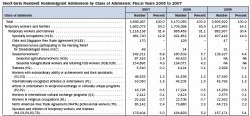 As the recession deepens and job losses set records, the finger of blame, which has up to now been pointed at the bankers and Wall Street brokers — and, of course, the politicians — is inevitably turning to include outsourcing and U.S. immigration policies.
As the recession deepens and job losses set records, the finger of blame, which has up to now been pointed at the bankers and Wall Street brokers — and, of course, the politicians — is inevitably turning to include outsourcing and U.S. immigration policies.
Within hours of BusinessWeek posting the story about the loss of 533,000 jobs in November, posters were complaining about the number of H-1B visas and other work permits the government is issuing. The Huffington Post’s special recession site has a give and take on the subject with the dishers outnumbering the defenders of temporary workers.
The criticism of U.S. foreign worker policy ebbs and flows with the economy, but it never entirely goes away. Witness the furor a year ago over the illegal immigration bill debated in Congress and eventually killed in the House of Representatives, despite the support of President Bush.
In 2005, in the midst of the national recovery that was especially strong in the IT sector, the USA president of the IEEE (Institute of Electrical and Electronics Engineers) warned, “The drop in computer programmers and rise in managers reflects the trend toward offshoring of programming jobs and the resulting need for professionals to manage outsourced projects.” Gerard A. Alphonse added, “…offshoring not only contributes significantly to U.S. high-tech unemployment, but also suppresses wages.”
The issue even came up early in the presidential election when both Hillary Clinton and Barack Obama signaled they weren’t sold on outsourcing and might end tax breaks for companies that offshore.
And the debate about outsourcing and what it is doing to the U.S. continues; pro and con. The challenge however, is that there is no reliable source of data on how many jobs are in question. Plunkett Research offers some guidance concerning the size of the market economically, while two Canadian researchers found a small, but positive impact on the U.S. from service sector offshoring.
Only when it comes to temporary workers are there any reliable numbers. In the report for fiscal 2007, the Office of Immigration Statistics said 1.1 million temporary workers were admitted to the country. That number is merely the number of times individuals with some form of work visa passed through customs. It excludes those with green cards (permanent resident status), but includes all other form of work permits. However, the report shows that the number of admissions has been growing steadily, with the largest increase coming in two areas: seasonal agricultural workers and H-1B holders.
U.S. Citizenship and Immigration Services approved just over 126,000 H-1B visa petitions in fiscal 2007 (which ended Sept. 30) despite a supposed cap of 65,000 plus 20,000 supplemental for persons with advanced degrees from U.S. schools.
Companies like Microsoft, Cisco, Oracle, and Infosys are among the biggest users of the H-1B visa process.
The process for 2009 visas is already underway and there is no reason to believe the quota won’t be filled as early as it was last year. Nor is it likely that the cap will be reduced, despite President-elect Obama’s avowed desire to overhaul the immigration process.
Speaking to an Indian newspaper following a conference of the Federation of Indian Chambers of Commerce and Industry, the U.S. consul general in Chennai, Andrew T. Simkin, said a change in the visa numbers was “Not likely.” “It is a serious thing requiring legal amendments and I do not think this could be a priority,” he was quoted as saying.